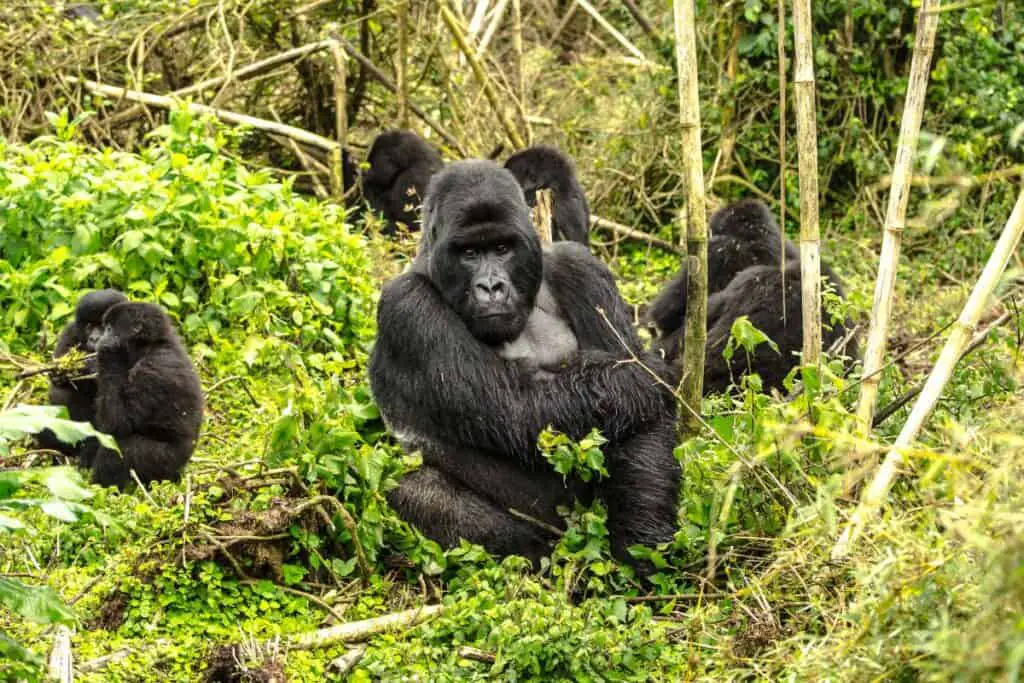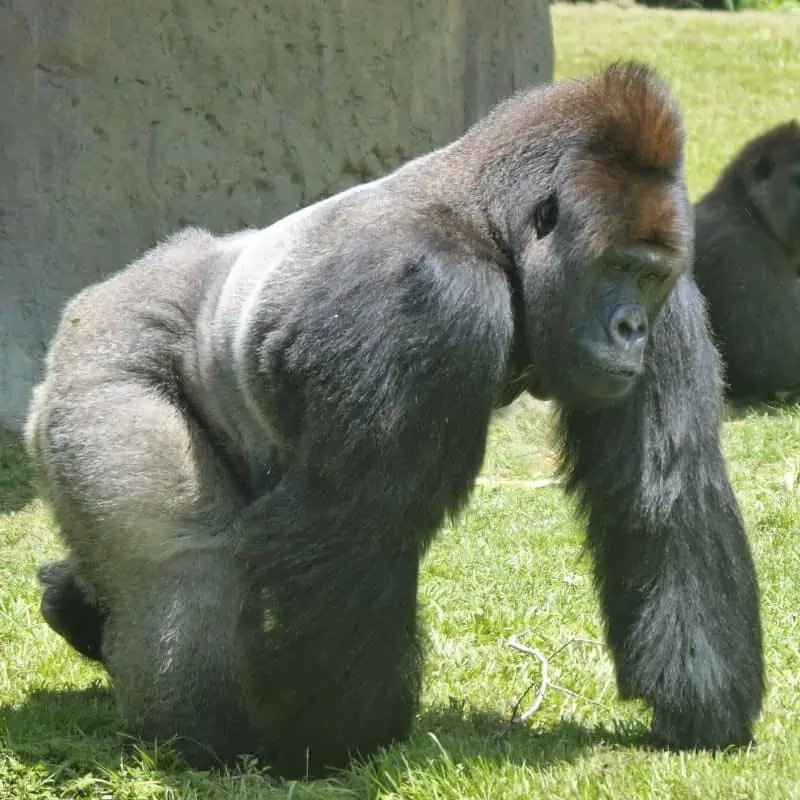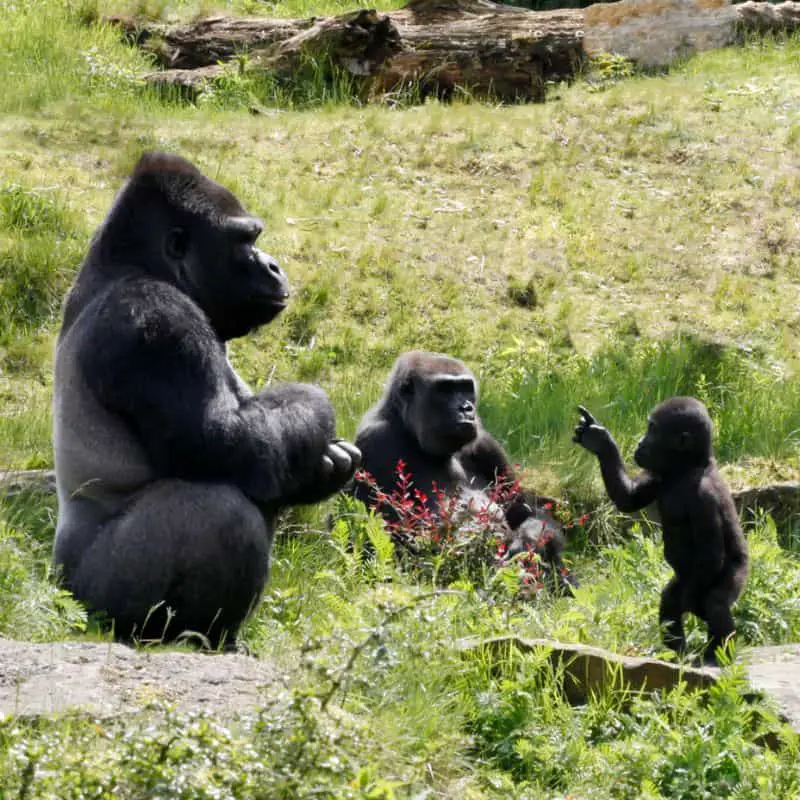Gorillas are very social animals and tend to live in groups. But what do you call them if you come across one? What is a group of gorillas called?
A group of gorillas is sometimes referred to as a family; however, the correct terms are a band or troop of gorillas. It is also considered correct if you refer to them as a group. A more informal name for a collection of gorillas is a whoop, which came about due to a comedy skit.
In this article, we’ll look a little further and break down the social structure of these groups to see how they interact.

A group of gorillas is either a band or a troop
To begin with, gorillas are the largest and most powerful primates. And as with other primates such as chimpanzees, biologically, they are incredibly closely related to us human beings.
Unlike many of us who dwell in cities, though, they often live in social groupings in areas that are tropical rainforests. These groups are usually referred to as troops or bands.
The groups of gorillas are also referred to as families, and although it is rare, these groups can consist of between as few as five or as many as 30 different members.
These members include the dominant male, a silverback, the females, and their young offspring. At times, other male gorillas also make up part of the band.
The Silverback is the oldest yet strongest male, and he is the one who runs the show and is in charge of the security and protection of the group.

Additionally, he is the only male permitted to mate with the females.
If another male in the group attempts to mate with one of the females, the silverback and he will engage in a violent contest, and the loser will have to leave.
When we break down the formation of the gorilla group, the family is often the smallest collection of gorillas.
After that, you get what is referred to as bachelor groups, made up of young males who have broken away from their original band and are in search of starting their own families.
Another less common way to refer to a group of gorillas is a “whoop of gorilla,” derived from the show “Not the Nine O’Clock News.” And it came about due to the popularity of “Gerald the Gorilla,” who was part of a skit where Rowan Atkinson wore a gorilla suit.
The strange thing is that although the term was merely made up and coined by the show, it has sometimes even shown up in scientific papers and books.
This shows how influential mainstream media and entertainment can be at times.
Typical gorilla troop size and make-up
We now have a firm grip on what a gorilla group is called and the different accepted terms, so let us look at the sizing of these troops and closely examine their social structures.
A troop usually consists of as few as two or 12 individual gorillas. However, this varies depending on the species and subspecies of the gorilla. The typical average is nine, though.
The silverback and his troop are highly synchronized and effective at communicating with one another and seamlessly go about their daily activities.
The silverback is typically between the ages of 12 and 13, and he is referred to as a silverback due to the distinctive silver hair patch on his back, which signifies that he has reached full adulthood.
Both male and female gorillas tend to depart from their original band at a certain age, while some might choose to stay.
The number of females who emigrate often differs, depending on the type of gorillas. In the rare case of multiple silverbacks in a group, the dominant one is usually the father of the others, and they submit to him.
The adult males who decide to depart from their families go out to seek to start their own bands, and if physically dominant than others, they are more likely to attract emigrating females.

As mentioned, sometimes the males remain with their troops, and in these cases, they will act as additional protection for the group and will be subordinated to the head silverback.
The dominant silverback makes the decisions regarding movements and where and when the group will feed.
He holds much responsibility, although his primary function is guarding the troops against internal disagreements and external threats. Often the silverback will be willing to fight to the death for his band.
The younger subordinate males, known as blackbacks (as they do not possess the silver hair on their backs), will help the silverback in times of conflict, especially when predators or opposing silverbacks attempt to take over the troop.
If the silverback dies, the group can become unstable; however, if there is a capable male, he may be chosen as leader.
Different species of gorillas
There are two primary types of gorillas; firstly, the Western gorilla (or Gorilla gorilla). The group sizes for this type of gorilla span from 2-20 individual members, and there will be one dominant male, several females, and their offspring.
For this species, it is far more common for the younger males and females, who reach maturity, to leave to find their own troops.
This species in Western Africa is divided into two subspecies: the Western lowland gorilla and the Cross river gorilla.
The second gorilla species is the Eastern gorilla (or Gorilla beringei) .
Their troops can also hold as few as two members but sometimes reach as many as 35 individuals; generally, their troops are larger than the Western gorilla.
This gorilla species is found in Central Africa and is divided into two subspecies. The first is the Moutain gorilla (sometimes called Congo Mountain gorilla), and the second is the Eastern lowland gorilla (or Grauer’s gorilla).
Unlike the Western gorilla, the females in this species are likelier to stay loyal to the dominant silverback for life (this is not always the case as there are always exceptions).
You may have seen gorillas in captivity; however, they will not have been Mountain gorillas. These gorillas, the largest type of gorillas, have never been tamed (even though you can go on guided tours where they are at least familiar with human presence).
Between the 1950s and 1980s, zoos paid poachers to steal young gorillas from their parents, but the babies never survived.
So if you wish to see Mountain gorillas, even today, you will need to go on a trip referred to as gorilla trekking, where a qualified guide will take you through the tricky terrain to spend an hour viewing these glorious creatures up close and personal.
If you want a once-in-a-lifetime experience, consider going on one of these expeditions, as they can be truly life-altering.
These treks also often help support the environment these gorillas call home, one of the biggest factors affecting their lowering numbers.
Gorillas and their typical days and diets
Most of a band of gorillas’ day is spent foraging and feeding; this typically accounts for 14 hours of their day, and the remaining 10 hours they spend sleeping or resting and relaxing.
Their foraging and eating period usually peaks during the initial 3-4 hours of the day. After that, there is an extended period of resting until they continue foraging in the late afternoon.
Gorillas tend to stay in a limited space and are not highly territorial creatures; their concern is for the troop’s safety. In a single day, they will only travel between 0.24-0.6 miles (400-1,000 meters).
This reflects their relaxed and placid demeanors and is a testament to their typically staying in one place unless forced to move for unforeseen reasons.
Gorillas may return to their “beds” or what is often referred to as nests at the end of the day.
These nests are constructed from vegetation surrounding them; sometimes, they might have changed location and thus make new nests.
The construct of the nests varies, but they are usually made up of vines and soft branches. The nests keep them elevated from the cold earth at night.
Final thoughts on gorilla groupings
A troop of gorillas or a band of gorillas are the most widely accepted terms to refer to a group of gorillas.
There are other less “correct” ways of referring to them, such as families and bachelor groups (where young adult males form groups).
Or, if you’re feeling whimsical, you can always call them a whoop of gorillas.
